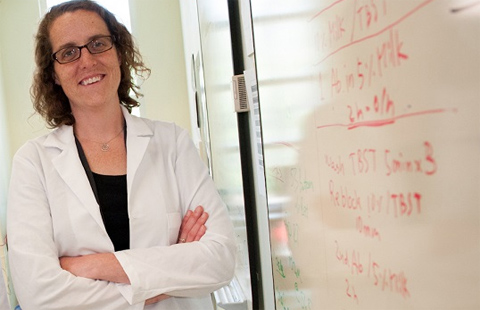
Dr. Todd Young. Photo by Joel Prince, courtesy of the Ohio University Heritage College of Osteopathic Medicine
By Andrea Gibson
From Research Communications
An Ohio University mathematician and a bacteriologist are joining forces to try to prevent pneumonia in hospital patients on ventilators, a common health care-acquired infection.
Dr. Todd Young, Professor of Mathematics, and Dr. Erin Murphy, Associate Professor of Biomedical Sciences in the Heritage College of Osteopathic Medicine, received a $10,000 seed grant earlier this year from the medical college’s Research and Scholarly Affairs Committee to study how to identify strains of bacteria growing on hospital ventilator filters. They hope their work leads to a new bedside diagnostic tool that could detect bacteria early and thwart pneumonia cases.
Young has been working on the project for several years with scientist Erik Boczko, who recently joined Ohio University from Vanderbilt University. Their clinical study confirmed that researchers can recover bacterial DNA from the ventilator filters in order to identify the cause of the infection. The team also created a mathematical model to describe the innate immune system—which, unlike the body’s general immune system, responds to specific threats—in the lungs. The model can help researchers detect how and when pneumonia infections start, Young said.
After publishing two academic journal articles on the topic, “we were ready for some expertise in bacteria and newer methods of DNA sequencing,” Young recalled. When a colleague mentioned Murphy to Young last year, he suspected that she would be a good fit for the project. Murphy has published research findings on the molecular mechanisms of how the Shigella bacterium causes diarrheal illness and also has studied bacterial meningitis.

Dr. Erin Murphy, Photo by John Sattler, Courtesy of the Ohio University Heritage College of Osteopathic Medicine
This year, Murphy will grow 10 different organisms in the lab to determine if the researchers can specifically identify them on the ventilator filters. The scientists will use genetic analysis, accessing equipment in the Ohio University Genomics Facility at Porter Hall, to rapidly detect the bacteria. It’s a process that has been used elsewhere to analyze bacterial content from soil samples and food, but hasn’t been used at Ohio University until now, Murphy said.
“I’m excited about the project because it allows two people to use basic sciences that are very different to address a real clinical problem,” she said. “It’s not often that I think my basic science can address something that can help an actual patient.”
Recent clinical studies suggest that between 5 and 15 percent of ventilated patients acquire pneumonia, and a small portion of those individuals die from the infection. New insurance laws make hospitals more financially liable for the problem, given that it is largely preventable, Young and Murphy noted.
The researchers hope to complete the pilot phase of the project by the end of summer 2015.



















Comments